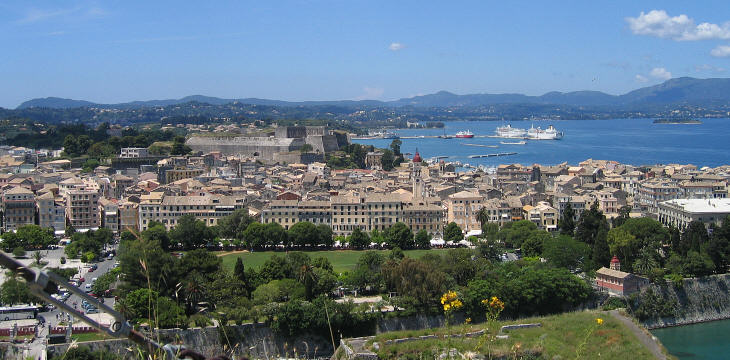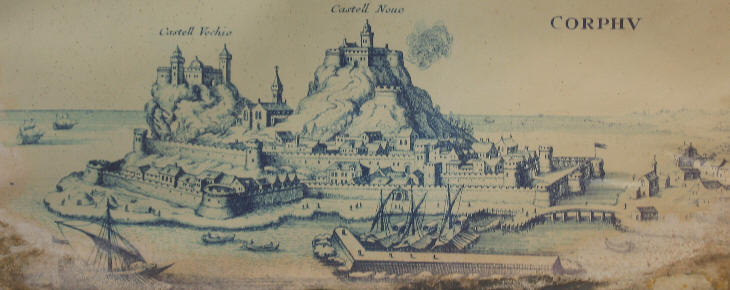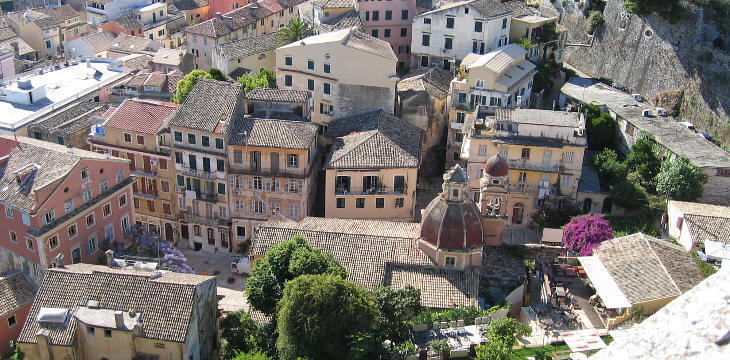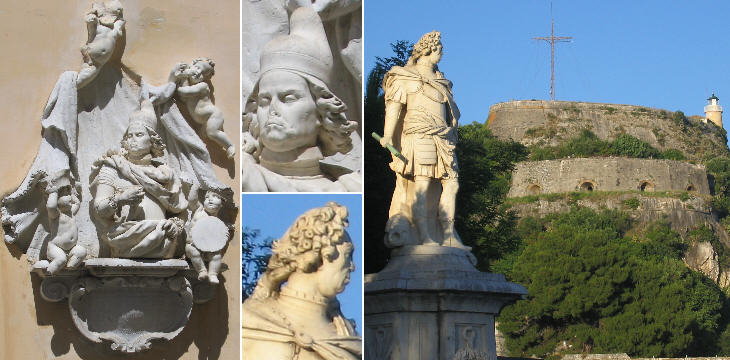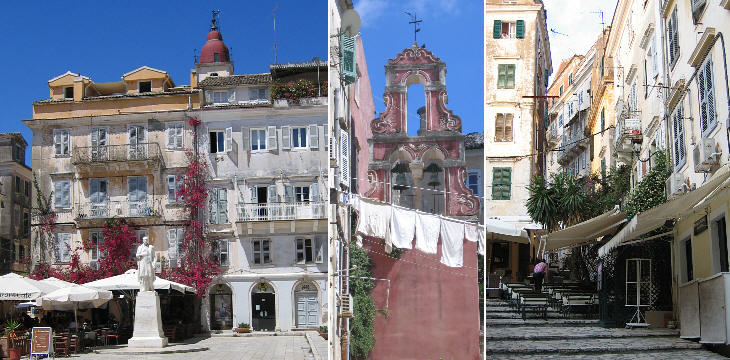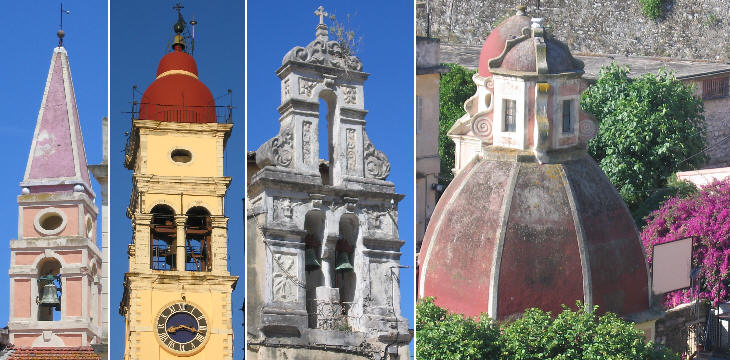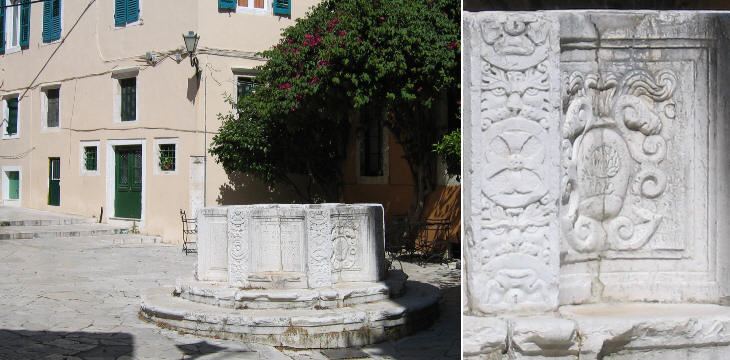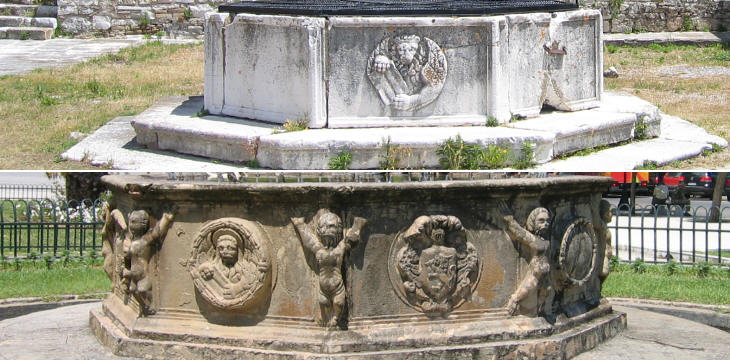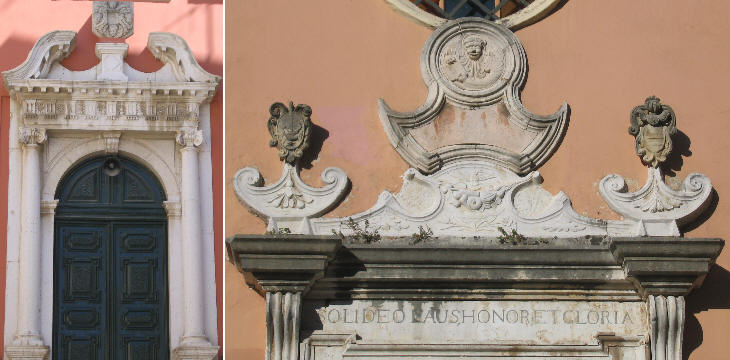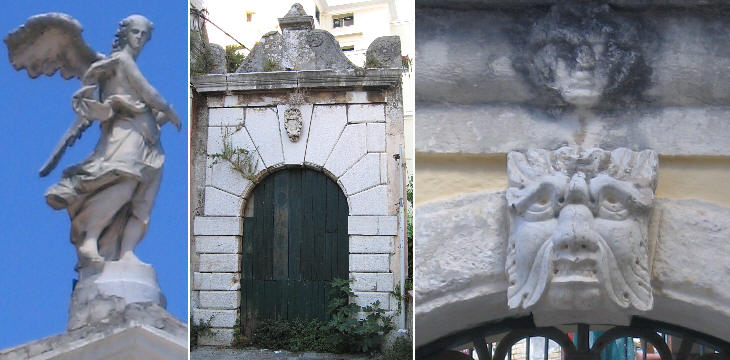  What's New! Detailed Sitemap All images © by Roberto Piperno, owner of the domain. Write to romapip@quipo.it. Text edited by Rosamie Moore. Page added in July 2007. |
  Corfu: the Old Town Corfu: the Old Town
In June 2007 the Old Town of Corfu was added to the UNESCO World Heritage List. The list includes more than 850 cultural and natural sites (as of June 2007). From the time of the oldest (The Seven Wonders of the Ancient World), all such inventories have been highly debatable and the UNESCO one is not an exception: Rome was first included on the list as the "Historic Centre of the City of Rome" and regarded as a site belonging to Italy; some years later Vatican City was added to the list as a site belonging to the Holy See as if it were not already comprised in the first caption and to make things more confusing the Properties of the Holy See in Rome (i.e. S. Giovanni in Laterano, S. Maria Maggiore, S. Paolo fuori le Mura to name the most important ones) were regarded as a third separate site. The selection of archaeological sites is quite puzzling: Ephesus, Pergamum are not on the list, while other locations which do not have comparable monuments/historical importance have been included.
UNESCO stated that the "Old Town of Corfu (Greece), on the Island of Corfu, with its three Venetian forts and neo-classical housing was inscribed as a fortified Mediterranean port town of high integrity and authenticity." While it is correct to quote three forts, two of them are usually jointly referred to as the Old Fortress (see a page on the fortifications of the town).
The old town of Corfu is from a certain point of view a new town; until the early XVIth century the center of the town was inside the old fortress. It was relocated to its current location when the Venetians built a new fortress to the west of the existing one. The new town developed in the space between the two fortresses and was surrounded by walls.
The layout of the old town resembles very much that of Venice with tall buildings (due to the shortage of space in relation to the population), a maze of narrow streets and small piazzas around a church.
Francesco Morosini skilfully presided over the defence of Candia: the town eventually fell in 1669 after a siege which lasted more than twenty years, but Morosini managed to negotiate a honourable peace agreement. In 1684 Venice declared war on the Ottomans: Morosini conquered Santamaura, Vonizza and Preveza; in the next year the Venetians conquered most of Morea and in 1687 Morosini laid siege to Athens which was occupied after just six days. In 1688 Morosini was elected Doge, the chief magistrate and leader of the Republic. The monument portrays him wearing Corno Dogale, a stiff horn-like bonnet, which was made of brocade. It is interesting to note that the monument was built in 1690 when Morosini was still alive, a honour which the Republic of Venice very rarely granted. Another exception was made for Johann Matthias Count von Schulenberg who was in charge of the defence of Corfu during its 1716 siege: the statue is a work by Antonio Corradini, a leading Venetian sculptor: he portrayed Schulenberg as an ancient Roman emperor (but wearing Renaissance armour and an XVIIIth century wig).
The statement of UNESCO makes reference to neoclassical housing, but the character of the old town is anything but neoclassical: rather it is a concentration of Mediterranean atmosphere.
The old town has plenty of interesting buildings of the XVIIth and XVIIIth centuries: an abundance which is unique in Greece. The bell tower of the Catholic cathedral resembles that of St. Mark's square in Venice.
This small square is not easy to find, but it is worth the effort: in 1690 Antonio Cocchini, member of a prominent family in the Ionian Islands, built a pretty well-curb PRO COMMUNI BENEFICIO (the inscription is written also in Greek). The area is rightly called Campiello, the name given in Venice to small piazzas.
Other well-curbs can be found in the old town and the old fortress: they may not be the work of prominent artists, but they add to the Venetian character of Corfu.
The Venetians left a wide empty space between the old fortress and the first buildings; it was a military safeguard in case the Ottomans managed to seize the new fortress and enter the town: they would not be able to hide behind houses when launching their assault on the last Venetian stronghold. The site is still called Spianada after the Italian word spianata, meaning a large flat ground: the French turned it into a garden flanked by a series of buildings with porticoes; the British added a cricket playing ground and a large neoclassical residence for the governor (see the first image of this page). Today's inhabitants of Corfu do not include these additions in Palea Poli (old town), where Baroque is definitely the most prevalent style.
Move to Corfu - the fortifications. Introductory page on the Venetian Fortresses Pages of this section: On the Ionian Islands: Corf¨ (Kerkyra) Paxo (Paxi) Santa Maura (Lefkadas) Cefalonia (Kephallonia) Asso (Assos) Itaca (Ithaki) Zante (Zachintos) Cerigo (Kythera) On the mainland: Butrinto (Butrint) Parga Preveza and Azio (Aktion) Vonizza (Vonitsa) Lepanto (Nafpaktos) Atene (Athens) On Morea: Castel di Morea (Rio), Castel di Rumelia (Antirio) and Patrasso (Patra) Castel Tornese (Hlemoutsi) and Glarenza Navarino (Pilo) and Calamata Modon (Methoni) Corone (Koroni) Braccio di Maina, Zarnata, PassavÓ and ChielefÓ MistrÓ Corinto (Korinthos) Argo (Argos) Napoli di Romania (Nafplio) Malvasia (Monemvassia) On the Aegean Sea: Negroponte (Chalki) Castelrosso (Karistos) Oreo Lemno (Limnos) Schiatto (Skiathos) Scopello (Skopelos) Alonisso Schiro (Skyros) Andro (Andros) Tino (Tinos) Micono (Mykonos) Siro (Syros) Egina (Aegina) Spezzia (Spetse) Paris (Paros) Antiparis (Andiparos) Nasso (Naxos) Serifo (Serifos) Sifno (Syphnos) Milo (Milos) Argentiera (Kimolos) Santorino (Thira) Folegandro (Folegandros) Stampalia (Astipalea) Candia (Kriti) You may refresh your knowledge of the history of Venice in the Levant by reading an abstract from the History of Venice by Thomas Salmon, published in 1754. The Italian text is accompanied by an English summary. Clickable Map of the Ionian and Aegean Seas with links to the Venetian fortresses and to other locations (opens in a separate window) |
